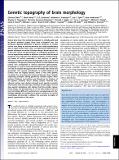| dc.contributor.author | Chen, Chi-Hua | |
| dc.contributor.author | Fiecas, Mark | |
| dc.contributor.author | Gutierrez, E. D. | |
| dc.contributor.author | Panizzon, Matthew S. | |
| dc.contributor.author | Eyler, Lisa T. | |
| dc.contributor.author | Vuoksimaa, Eero | |
| dc.contributor.author | Thompson, Wesley K. | |
| dc.contributor.author | Fennema-Notestine, Christine | |
| dc.contributor.author | Hagler, Donald J., Jr. | |
| dc.contributor.author | Jernigan, Terry L. | |
| dc.contributor.author | Neale, Michael C. | |
| dc.contributor.author | Franz, Carol E. | |
| dc.contributor.author | Lyons, Michael J. | |
| dc.contributor.author | Fischl, Bruce | |
| dc.contributor.author | Tsuang, Ming T. | |
| dc.contributor.author | Dale, Anders M. | |
| dc.contributor.author | Kremen, William S. | |
| dc.date.accessioned | 2014-08-29T14:05:21Z | |
| dc.date.available | 2014-08-29T14:05:21Z | |
| dc.date.issued | 2013-10 | |
| dc.date.submitted | 2013-04 | |
| dc.identifier.issn | 0027-8424 | |
| dc.identifier.issn | 1091-6490 | |
| dc.identifier.uri | http://hdl.handle.net/1721.1/89108 | |
| dc.description.abstract | Animal data show that cortical development is initially patterned by genetic gradients largely along three orthogonal axes. We previously reported differences in genetic influences on cortical surface area along an anterior-posterior axis using neuroimaging data of adult human twins. Here, we demonstrate differences in genetic influences on cortical thickness along a dorsal-ventral axis in the same cohort. The phenomenon of orthogonal gradations in cortical organization evident in different structural and functional properties may originate from genetic gradients. Another emerging theme of cortical patterning is that patterns of genetic influences recapitulate the spatial topography of the cortex within hemispheres. The genetic patterning of both cortical thickness and surface area corresponds to cortical functional specializations. Intriguingly, in contrast to broad similarities in genetic patterning, two sets of analyses distinguish cortical thickness and surface area genetically. First, genetic contributions to cortical thickness and surface area are largely distinct; there is very little genetic correlation (i.e., shared genetic influences) between them. Second, organizing principles among genetically defined regions differ between thickness and surface area. Examining the structure of the genetic similarity matrix among clusters revealed that, whereas surface area clusters showed great genetic proximity with clusters from the same lobe, thickness clusters appear to have close genetic relatedness with clusters that have similar maturational timing. The discrepancies are in line with evidence that the two traits follow different mechanisms in neurodevelopment. Our findings highlight the complexity of genetic influences on cortical morphology and provide a glimpse into emerging principles of genetic organization of the cortex. | en_US |
| dc.description.sponsorship | National Institute on Aging (Grant AG022381) | en_US |
| dc.description.sponsorship | National Institute on Aging (Grant AG018386) | en_US |
| dc.description.sponsorship | National Institute on Aging (Grant AG018384) | en_US |
| dc.description.sponsorship | National Institute on Aging (Grant AG022982) | en_US |
| dc.description.sponsorship | National Institute on Aging (Grant AG031224) | en_US |
| dc.description.sponsorship | National Institute on Drug Abuse (Grant DA029475) | en_US |
| dc.description.sponsorship | National Institute of Neurological Disorders and Stroke (U.S.) (Grant NS056883) | en_US |
| dc.language.iso | en_US | |
| dc.publisher | National Academy of Sciences (U.S.) | en_US |
| dc.relation.isversionof | http://dx.doi.org/10.1073/pnas.1308091110 | en_US |
| dc.rights | Article is made available in accordance with the publisher's policy and may be subject to US copyright law. Please refer to the publisher's site for terms of use. | en_US |
| dc.source | PNAS | en_US |
| dc.title | Genetic topography of brain morphology | en_US |
| dc.type | Article | en_US |
| dc.identifier.citation | Chen, C.-H., M. Fiecas, E. D. Gutierrez, M. S. Panizzon, L. T. Eyler, E. Vuoksimaa, W. K. Thompson, et al. “Genetic Topography of Brain Morphology.” Proceedings of the National Academy of Sciences 110, no. 42 (September 30, 2013): 17089–17094. | en_US |
| dc.contributor.department | Massachusetts Institute of Technology. Computer Science and Artificial Intelligence Laboratory | en_US |
| dc.contributor.mitauthor | Fischl, Bruce | en_US |
| dc.relation.journal | Proceedings of the National Academy of Sciences | en_US |
| dc.eprint.version | Final published version | en_US |
| dc.type.uri | http://purl.org/eprint/type/JournalArticle | en_US |
| eprint.status | http://purl.org/eprint/status/PeerReviewed | en_US |
| dspace.orderedauthors | Chen, C.-H.; Fiecas, M.; Gutierrez, E. D.; Panizzon, M. S.; Eyler, L. T.; Vuoksimaa, E.; Thompson, W. K.; Fennema-Notestine, C.; Hagler, D. J.; Jernigan, T. L.; Neale, M. C.; Franz, C. E.; Lyons, M. J.; Fischl, B.; Tsuang, M. T.; Dale, A. M.; Kremen, W. S. | en_US |
| mit.license | PUBLISHER_POLICY | en_US |
| mit.metadata.status | Complete | |
